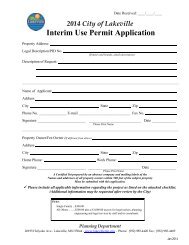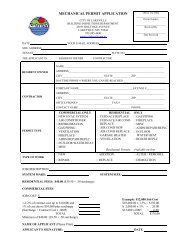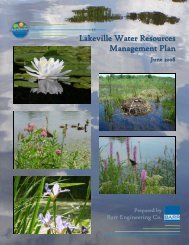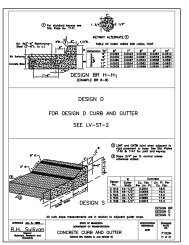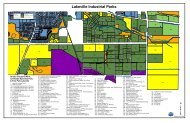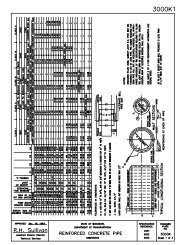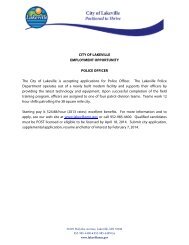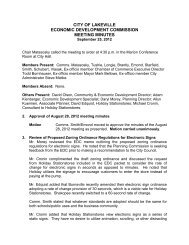Water conservation techniques - City of Lakeville
Water conservation techniques - City of Lakeville
Water conservation techniques - City of Lakeville
You also want an ePaper? Increase the reach of your titles
YUMPU automatically turns print PDFs into web optimized ePapers that Google loves.
Money-saving tips• Check your water meter and water bill totrack your water usage. Being aware <strong>of</strong>how much you use is the first step in water<strong>conservation</strong>.• Use your water meter to check for hiddenwater leaks. Read the house water meterbefore and after a two-hour period when nowater is being used. If the meter does notread exactly the same, there is a leak.• Install water-saving shower heads and lowflowfaucet aerators.• Check for leaks in pipes, hoses, faucets, andcouplings. Leaks outside the house maynot seem as bad since they’re not as visible.Check frequently to keep them drip-free.Use hose washers at spigots and hoseconnections to eliminate leaks.Did you know?Did you know that an American home canwaste, on average, 11,000 gallons <strong>of</strong> water everyyear due to running toilets, dripping faucets,and other household leaks? According to theEnvironmental Protection Agency, nationwide,more than 1 trillion gallons <strong>of</strong> water leak fromU.S. homes each year. Use the valuable watersavingtips in this brochure and check for manymore tips and ideas on the <strong>City</strong> website atwww.lakevillemn.gov.<strong>Water</strong> is too valuable to waste.<strong>Water</strong> facts• In 2013, <strong>Lakeville</strong> pumped 2.29 billion gallons<strong>of</strong> water.• <strong>Water</strong> covers 70 percent <strong>of</strong> the earth’s surface.• Ninety-seven percent <strong>of</strong> the world’s water issalty or otherwise undrinkable.• Two percent is locked in ice caps or glaciers.• One percent remains to meet all <strong>of</strong> humanity’sneeds.<strong>Lakeville</strong> wateringordinanceResidents may water every other day, using anodd/even schedule. If your house number ends inan odd number, you may water on odd numbereddays <strong>of</strong> the month. If your house number endsin an even number, you may water on evennumbered days <strong>of</strong> the month. In addition, youmay only water before 11 a.m. and after 5 p.m.Remember:Just because it’s your day to water,doesn’t mean you should.<strong>Water</strong> only if needed.www.lakevillemn.gov<strong>Water</strong>ConservationWhat’s in itfor me?
<strong>Water</strong> <strong>conservation</strong>…Saves money<strong>Water</strong> <strong>conservation</strong> today can save you moneyon your next water bill. The more you conserve,the more you save.A family <strong>of</strong> four in <strong>Lakeville</strong> uses about 238gallons <strong>of</strong> water per day, costing about $25per quarter. However, during the summer, theaverage use skyrockets to 924 gallons per day,per family, nearly quadrupling their quarterlybill. This high use costs a family <strong>of</strong> four about$95 for the summer quarter.March average use:About 238 gallons perday for a family <strong>of</strong> fourIf families used <strong>conservation</strong> measures duringthe summer and throughout the year, theycould save more than 20 percent on their waterbill. Check your water bill to see how muchwater you are using and calculate how muchyou could be saving.Saves resourcesAugust average use:About 924 gallons perday for a family <strong>of</strong> four<strong>Water</strong> is one <strong>of</strong> the most valuable resources <strong>of</strong>all. But what can one individual – or a singlefamily – do to help? The answer is in thefollowing water-saving tips.You can saveoutdoorsOutdoor watering uses muchmore water than any otherhousehold activity. Individual water use nearlyquadruples during the summer. Roughly half<strong>of</strong> the water used in <strong>Lakeville</strong> is used outdoors.Research suggests that much <strong>of</strong> the extra wateruse is wasted and that means wasted money. Hereare some easy ways for you to save water andmoney:• Adjust sprinklers so that only your lawn iswatered and not the house, sidewalk, or street.• Always water before 11 a.m. and after 5 p.m.when temperatures are cooler, to minimizeevaporation.• Only water your lawn when it’s needed. Youcan tell this by simply walking across yourlawn. If you leave footprints, it’s time to water.• Adjust your lawn mower to a higher setting.Longer grass will reduce the loss <strong>of</strong> water toevaporation.• Even though you are allowed to water everyother day according to an odd/even schedule,it’s better to water about once a week andprovide about one inch <strong>of</strong> water. This willcreate healthier and stronger lawns. You canmeasure one inch by placing a tuna can aboutsix feet away from your sprinkler and waitingfor it to fill.• <strong>Water</strong> only as rapidly as the soil can absorbthe water. <strong>Water</strong> run<strong>of</strong>f is a huge waste.Save in yourkitchen• Run your dishwasherand washing machineonly when they are full.You could save 1,000 gallons a month.• If using a dishwasher, there is usually noneed to pre-rinse the dishes.• Soak your pots and pans instead <strong>of</strong> lettingthe water run while you scrape them clean.• Keep a pitcher <strong>of</strong> water in the refrigeratorinstead <strong>of</strong> running the tap for cold drinks,then every drop <strong>of</strong> water goes down you,not the drain.• Don’t run water while you clean vegetables.Just rinse them in a pan or sink <strong>of</strong> cleanwater.Save in yourbathroom• When brushing yourteeth, never leave tapwater running. You’ll save four gallons aminute and about 200 gallons a week for afamily <strong>of</strong> four.• Check your toilet for leaks. Put a few drops<strong>of</strong> food coloring in the tank. If it seeps intothe toilet bowl, you have a leak. Fix it andsave more than 600 gallons a month.• Avoid unnecessary toilet flushing. Flushingconsumes over 25 percent <strong>of</strong> the dailyhousehold consumption <strong>of</strong> water, usingabout 5-7 gallons per flush. Don’t use yourtoilet to flush away tissues, bugs, or otherdebris that can go in the trash instead.



